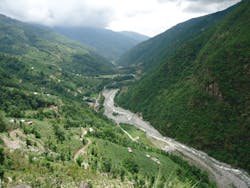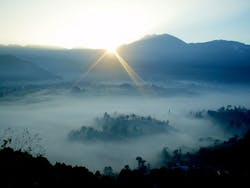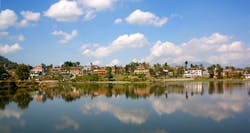Nepal: Moving Mountains in Melamchi
Financed by the Asian Development Bank, the multi-billion dollar Melamchi project aims to alleviate water shortages in Nepal capital city, Kathmandu. With construction delayed due to earthquakes and landslides, will the project be completed by September?
By Paul Grad
Several setbacks and delays have plagued the Melamchi Water Supply Project in the Nepal, which aims to solve the problems created by the perennial water shortage in the nation’s capital, Kathmandu, and the Kathmandu Valley. Strikes around the country, a fuel crisis, landslides and the earthquake of April 2015 were some of the reasons for the delays. As a result, it is now expected that the project will deliver water to the Kathmandu Valley by 2017.
With a population of about 28 million, Nepal is one of the poorest countries in the world. Much of the population lacks safe and adequate drinking water, with many surface and groundwaters contaminated by pollutants of industrial or domestic origin. Furthermore, only about 27% of the population has access to basic sanitation. As a consequence, there is a high incidence of water-bourne diseases such as diarrhea, dysentery, typhus, gastroenteritis, and cholera.
In some rural areas communities still rely on getting their drinking water from tube wells, with arsenic contamination being a recent concern.
Phase 1 and 2
The Melamchi Water Supply Project is therefore a priority project for the government and the many delays it has experienced have been a source of much distress. The whole project will cost an estimated Rs27 billion (US$2.5bn), financed mainly by the Asian Development Bank (ADB).
The Japan International Cooperation Agency (JICA) and the Organisation of Petroleum Exporting Countries (OPEC) Fund for International Development are also contributing finance for the project.
Initially all activities relating to the Melamchi Water Supply Project were carried out under the umbrella of the Melamchi Water Supply Development Board (MWSDB), but later the project was divided into Phases - or Subprojects - 1 & 2.
Responsibility to implement Phase 1 of the project has been assigned to the Melamchi Water Supply Development Board (MWSDB). This phase includes construction of a 26.5 km tunnel to divert raw water from Melamchi river to a water treatment plant at Sundarijal, and construction of the water treatment plant with initial capacity of at least 170,000 m3/day expandable to 510,000 m3/day.
Phase 2 is being implemented by the Project Implementation Directorate (PID) of Kathmandu Upatayaka Khanepani Limited (KUKL). This is a public company formed with the objective of undertaking and managing the water supply and sanitation system of the Kathmandu Valley. It operates under a License and Lease Agreement with the MWSDB for 30 years. Phase 2 of the project includes construction of service reservoirs at several locations in the Valley, and construction of bulk distribution system pipelines to convey water from the water treatment plant to the service reservoirs.
Construction is underway of six reservoirs at Arubari (8500 m3), Mahankalchaur (8000 m3), Bansbari (9500 m3), Balaju 7000 m3) and Maharajgunj (7500 m3) in Kathmandu, and Khumaltar (9500 m3) in Lalitpur. Completion of reservoir construction is targeted for April 2016.
Leakage reduction
To deliver materials, currently about 30 trucks with ductile iron pipes and other construction materials pipe and fittings are being delivered daily to Kathmandu from India.
About 300km of pipeline of the total of 700km has already been placed. The high density polyethylene pipe (HDPE PE 100) required for extending the pipeline is being produced in Nepal. The HDPE PE 100 pipes used to connect with the taps of the consumers are joined to their required lengths using the modern electro-fusion technology and this is expected to drastically reduce leakage.
The PID has accelerated the pace of pipeline extension work in line with the plan to distribute the water brought from Melamchi through a tunnel to each household in the valley. PID has also accelerated the capacity enhancement, rehabilitation, and construction of wastewater treatment plants in the valley. A 52km interceptor will be built along the Manohara and Hanumante rivers, the tributaries of the Bagmati river, while studies have begun for improving the old sewerage and extending the new one.
Both the diversion tunnel and the water treatment plant had been scheduled for completion on April/May 2016, but it now looks like the project will not be completed according to schedule, and a revised date of September 2016 has been set.
The diversion tunnel has been contracted to Italian consultant Cooperativa Muratori e Cementisti (CMC). The water treatment plant is being built by a consortium of Indian company Pratibha Group and Austrian company VA Tech Wabag GmbH.
About 12km of the diversion tunnel has been completed so far, employing the drill and blast method.
Landslides and earthquakes
CMC has been accused of delaying construction of the tunnel, blaming landslides, but according to contract the company is required to keep a buffer stock for at least a month, and should not interrupt construction at any time.
Ghanashyam Bhattarai, project chief and executive director of MWSDB, says construction had been delayed due to the earthquake but following this landslides caused obstruction to the project. “There have been landslides around the project site almost every day and there is a problem as work has to be done by clearing the debris,” he says.
He was also very critical of CMC. In an interview with Kathmandu Post he said CMC had agreed to work simultaneously in six sites but is actually working in only three. In August the company halted work for 15 days, citing lack of materials due to landslides in access roads. More recently, it again halted work, citing lack of materials due to strikes in several parts of the country.
He says the only option available to MWSDB to force CMC to comply with the terms of its contract with MWSDB is to issue warnings and deduct payments. But the company uses its political clout to prevent officials from resorting to those measures, Bhattarai adds. He says the project management can issue a “notice to correct”, which can lead to nullification of the contract if the company still fails to comply.
Project problems
Water expert Dipak Gyawali of the Nepal Water Conservation Foundation, and a former minister of water resources, points to other issues.
He says it’s been shown that 70% of the water in the mains is lost due to leakage from ageing pipes or pilferage. He says the problem is not so much the scarcity of water, but poor water management and wasteful distribution. “Assuming that water from Melamchi finally comes, who is going to distribute it? There are no maps. People don’t even know where the pipes are,” he says.
Another problem is demographic. Over the years, many people have settled down in the Kathmandu Valley. These people drilled wells everywhere causing the water table to fall, resulting in a water shortage. Guesthouses buy water from private suppliers and due to the high demand, prices have gone up. Local people, who can’t afford to buy that water have to harvest rainwater, or wait hours for their turn to fill jars at traditional water spouts.
The entire 170,000 m3/day of water from the water treatment plant will not be immediately available for distribution. Half of the water generated by the Melamchi Water Supply Project after completion will be used to regenerate the rapidly-drying Bagmati River as the existing water distribution capacity is inadequate to handle all the water. Furthemore, the water distribution network would be overloaded if all 170,000 m3/day of water was released at once.
Estimates suggest it will take five to seven years to complete the entire upgrade and therefore water will be released to Bagmati to prevent wastage. However, some Melamchi project officials say the deficit in water treatment capacity can be compensated by overloading the plant. Bhattarai says that despite the plant being designed to process water once every 24 hours, this can be extended to thrice daily to minimise wastage.
Consultancy services
A joint venture of three companies - Lahmeyer International GmbH, of Germany; and two Nepalese companies, Total Management Services, and Butwal Power Company - have provided management consulting services for the Melamchi Water Supply Project.
The overall objectives of the project management consultancy include: managing the overall procurement plan, assisting the MWSDB in all administrative and financial systems and assisting the Board in maintaining appropriate management information systems, among other tasks.
Environmental Protection
The Melamchi project includes a Social Upliftment Program (SUP) which has the aim to engage local participation in the mitigation of direct and indirect project impact. The idea is to create a base for long-term development in project-affected areas and to improve the quality of life in those areas.
The selected areas for SUP implementation include: preserving the Langtang National Park, developing a health plan for improving existing health care, developing and upgrading education in the Melamchi Valley, promoting income generation and community development activities through capacity building at the local level, formation of savings and credit groups, and launching a rural electrification program.
The Melamchi project’s environmental management program reviews all environmental impact assessments of the project to prevent any environmentally adverse effects in the future. As part of this, a monthly, quarterly and annual progress report will be prepared, as well as environmental protection activities, such as measuring noise and dust pollution, monitoring fish specimens, and measuring river discharge.
The Kathmandu water shortage problem is more than 100 years old. During the last few years, Nepal has experienced several social, political and natural upheavals. The country’s political environment seems now stable and the Melamchi project is expected to deliver a significant improvement in the country’s living standards in the next few years.
Paul Grad is a freelance writer for WWi magazine. For more information on the article, email: [email protected].
Fast Facts: Melamchi Water Supply Project
Phase 1
Construction of a 26.5km of tunnel from the Melamchi River to the water treatment plant at Sundarijal - about 12km completed so far - scheduled for completion on September 2016
Contracted to Cooperativa Muratori e Cementisti (CMC), of Ravenna, ItalyWater treatment plant with initial capacity of 170, 000 m3/day - about 70% completed so far - scheduled for completion on September 2016
Contracted to a consortium of Pratibha Group, of Mumbai, India; and VA Tech Wabag GmbH, of Vienna, Austria.
Phase 2
Construction of six service reservoirs - completion targeted for April 2016
Construction of a total of 700 km of bulk distribution ductile iron pipelines to convey water from the treatment plant to the service reservoirs. About 300km have been placed so far
Construction of a 52 km interceptor along the Manohara and Hanumante Rivers - tributaries of the Bagmati River
Management consulting services have been provided by a joint venture: Lahmeyer International GmbH, of Bad Vilbel, Germany; Total Management Services, of Kathmandu.
More Water & WasteWater International Archives Issue Articles



